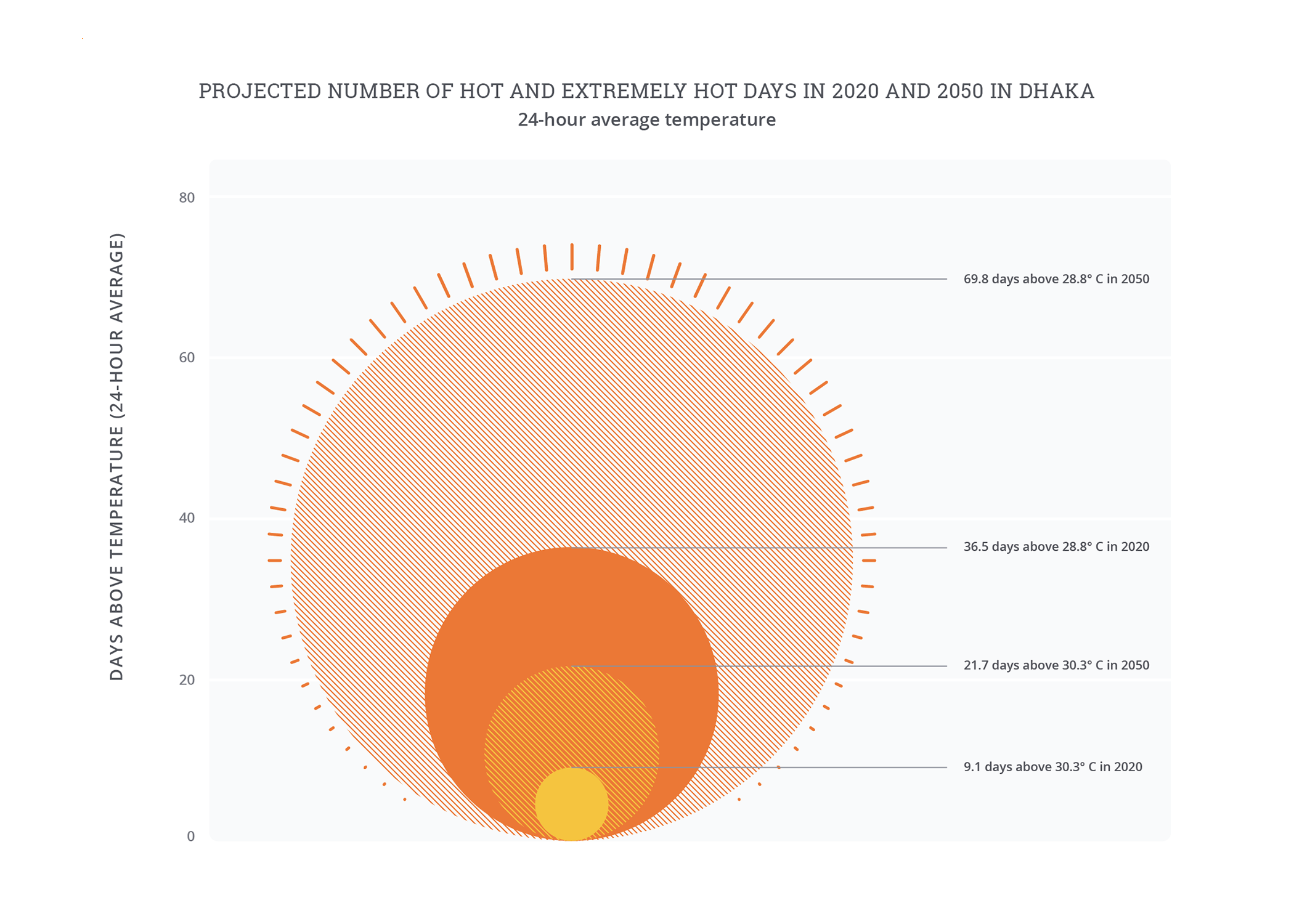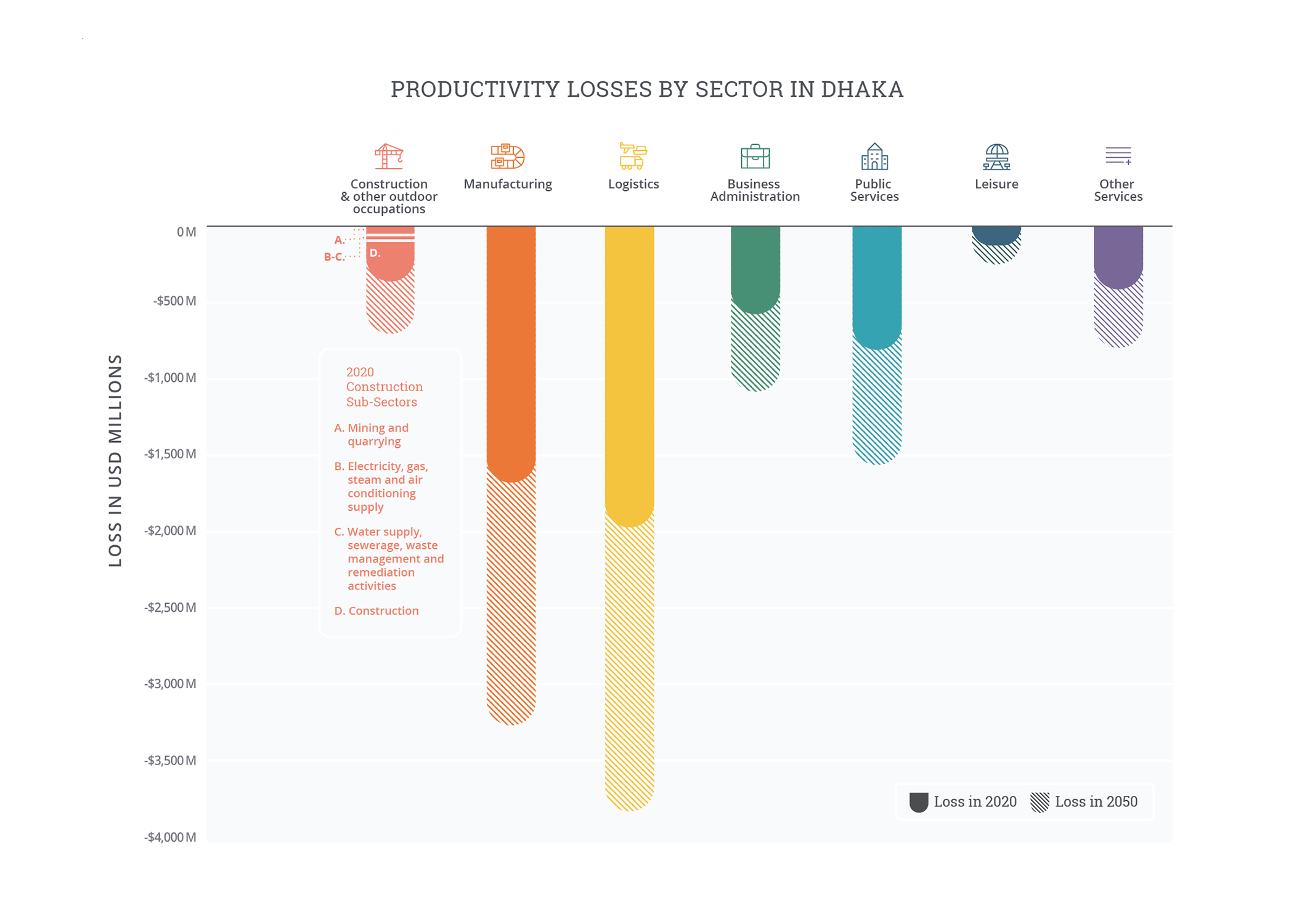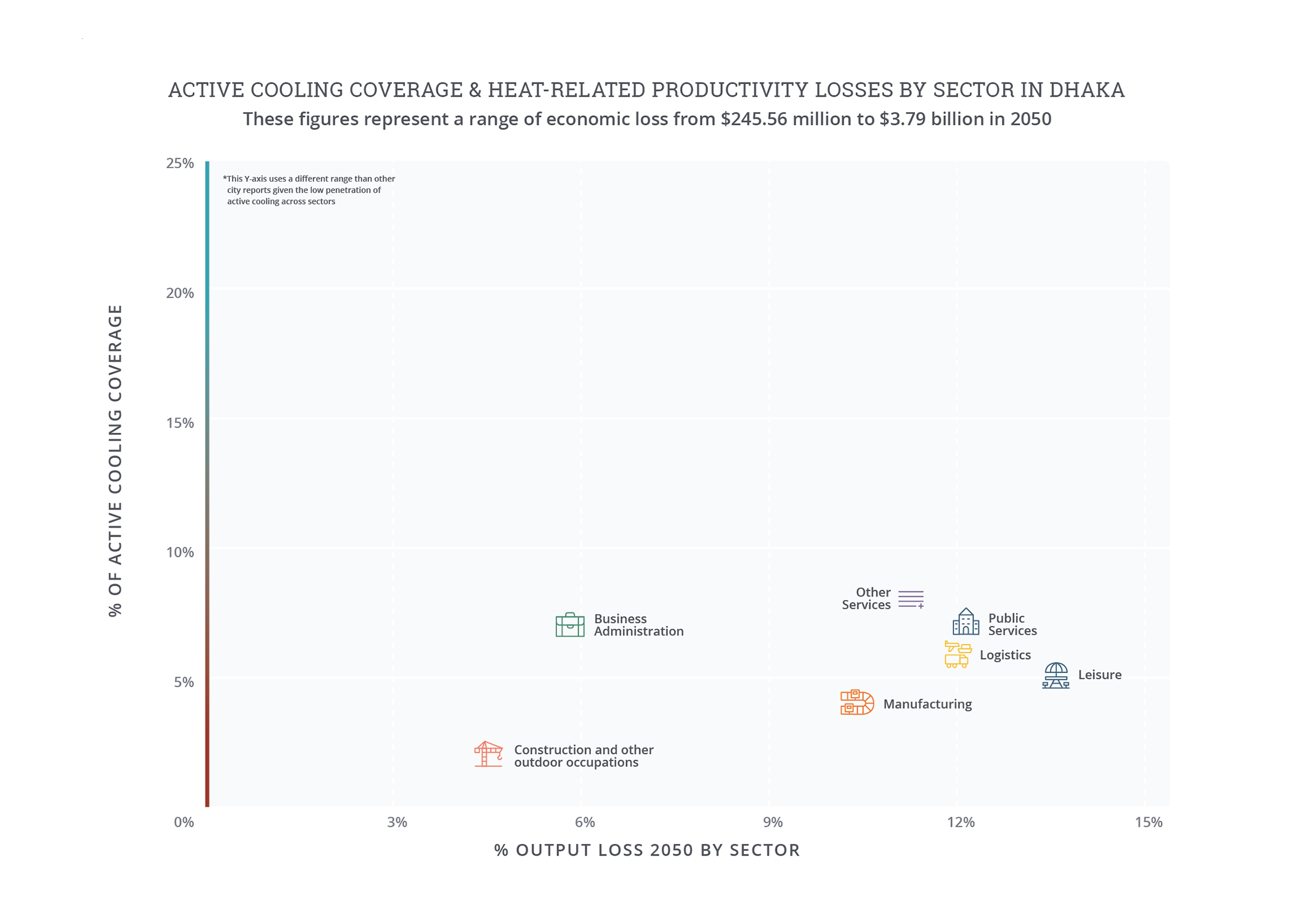Overview
High temperatures and humidity leave many in Dhaka exposed to dangerous weather conditions. For the ten hottest days of a typical year, the apparent temperature (considering both heat and humidity) is hotter than the human body.
The highest worker productivity-related economic losses from the heat are felt by those least able to bear them. In sectors such as garment manufacturing, transport, and retail trade, where wages can be lower than average, losses already amount to around 10 percent of income.
Heat is concentrated in some of the city’s poorest districts. In Kamrangirchar, a district containing a high concentration of informal settlements with widespread use of corrugated iron sheet roofing, temperatures are typically 12°C higher than Dhaka’s surroundings.
The population of Dhaka is developing innovative individual solutions to adapt to the heat, but the magnitude of the problem calls for a rapid scaling up of activity to protect the city’s residents and economy.
In Dhaka, heat stress impairs labor productivity more than any other city in this study, with losses valued at 8 percent of output under baseline conditions, rising to 10 percent by 2050 without action to reduce emissions or adapt.
Impacts of heat
Despite the already high temperatures and humidity of between 60 and 80 percent in Dhaka,1 climate change is set to make things substantially worse. In a typical year, the ten hottest days see average recorded temperatures greater than 30°C, which given local humidity feels warmer than the human body. There is little respite during the night, with overnight lows regularly over 25°C, making it difficult for people to cool off and recover from high daytime temperatures. Without action to reduce emissions, conditions will worsen substantially: by 2050 current extremes are projected to become more than twice as common.2
Heat in Dhaka is concentrated in its urban core, including some informal settlements. Dhaka is subject to a strong urban heat island (UHI) effect due to its population density and lack of green space. Large and widespread hotspots within the city are more than 10°C higher than the surrounding countryside.3
For example, in Kamrangirchar, population density and the widespread use of corrugated iron sheet roofing in buildings means that outside temperatures are typically 12°C higher than the city’s surroundings, while temperatures experienced indoors are even hotter. These living conditions contribute to substantial health risks for Dhaka’s population, which will only increase as temperatures rise further. Without action to reduce emissions or adapt, changes in temperatures as well as impacts from vector-borne diseases and air pollution are expected to worsen these conditions.4
In Kamrangirchar, population density and corrugated iron sheet roofing in buildings means that temperatures are typically 12°C higher than nearby areas.
Extreme heat and humidity cause labor productivity-related losses greater than 8 percent of annual output generated in Dhaka today5—and by 2050 this could increase to 10 percent.6 This is the highest share of losses of any city in this study: while others such as Abu Dhabi and Bangkok are more exposed to heat stress, Dhaka is unusually vulnerable to its effects, due to its labor-intensive economy and low rate of active cooling. Labor productivity causes output losses under current conditions that amount to around USD 6 billion (USD 5.9 billion/BDT 518 billion)7 in a typical year—comparable in real terms to estimates of the total economic losses to the whole of Bangladesh from the one-in-a-hundred-year flooding in 20048—rising to USD almost 12 billion (over BDT 1 trillion) by 2050 without adaptation, using conservative growth assumptions. These losses capture only direct impacts on output, but the lost wages and output also have indirect effects on the wider economy as overall spending declines and affects even economic activity that is not exposed to heat.
Low-income workers are especially exposed to heat: in sectors such as garment manufacturing, transport, and retail trade, losses already amount to around 10 percent of income. Losses are expected to be concentrated in sectors such as manufacturing and logistics, which already lose USD 1.5 billion (BDT 132 billion, or 9 percent of sectoral output) and USD 1.8 billion (BDT 158 billion, 10 percent of sectoral output), respectively. Losses in manufacturing are likely to be particularly high in sectors such as garment manufacturing or brick making, where proximity to machinery or ovens increases the temperature to which workers are exposed.9



Note on “Projected number of hot and extremely hot days”: Days where the twenty-four hour average (i.e., daily) temperature exceeds the local 90th percentile of the baseline average daily temperature are defined as “hot days,” while days where the daily temperature exceeds the local 97.5th percentile are defined as “extreme hot days.” Because hot days are relative to typical local temperatures, the same daily temperature may be considered “hot” in one city but not another. The baseline is based on historical climate data, 1985-2005, while 2050 is based on the 2040-2060 climate projection from an ensemble of CMIP6 models under RCP 7.0.
Note on “Productivity losses by sector”: The agricultural sector captures loss within the defined city limits and does not account for agricultural loss from the surrounding rural areas. Baseline losses are based on historical climate data from 1985-2005 and economic data from 2019. 2050 losses are based on the 2040-2060 climate projection from an ensemble of CMIP6 models under RCP 7.0 and economic models under SSP3. Losses assume no change in sectoral composition of economy. Source: Vivid Economics.
Note on “Active cooling coverage and heat related productivity losses by sector”: O*NET, 2021; and analysis by Vivid Economics.
Extreme heat interventions
The people of Dhaka have long lived with extreme heat and have developed innovative adaptations. However, the magnitude and expected increasing severity of the problem calls for a rapid scaling up of activity to protect the city’s residents and economy. Actions in progress include:
- Planning/policy: Worker protection projects such as the Red Cross/Red Crescent’s FbF solution can be scaled up to provide broad-based social insurance against extreme heat for vulnerable workers.
- Communications/outreach: There are existing weather forecasts from institutions such as the European Centre for Medium-Range Weather Forecasts and the Bangladesh Meteorological Department, while projects such as the Red Cross/Red Crescent’s feasibility study on heat waves are working to formalize locally relevant and scientifically backed heat wave definitions that could underpin future public health and safety campaigns.
- Investment in the built environment and nature-based solutions: The Million Cool Roofs challenge, which is a pilot study in Dhaka, has achieved significant cooling effects in schools, industrial buildings, and low-quality housing settlements through using reflective roof paint to reduce indoor temperatures. In one instance, indoor working temperatures at peak heat times dropped by almost 8°C, falling below outdoor temperatures. Further low-cost adaptations are already used by Dhaka residents, particularly in informal communities, including building on stilts to promote air circulation (and improve flood resilience) and establishing natural “green roofs” by allowing creepers to cover iron roofs. Existing street-shading is in high demand as hawkers and commuters both seek shelter from the sun in passenger sheds at bus stops or transit terminals. Trials of vehicles with green roofs have been experimented with in Dhaka as a way of cooling vehicles without the need for air conditioning and to promote awareness of green roof solutions.
Explore more city chapters
Return to the global summary
Endnotes
1 To estimate economic losses, this study goes beyond political boundaries to give a sense of how extreme heat and humidity impact Dhaka’s influence area. Core economic modeling considers the Dhaka metropolitan area. The regional approach is to ensure that analysis covers populations that are central to Dhaka’s growth and urban trajectory.
2 All analysis is based on RCP 7.0 and SSP3 using an ensemble mean of CMIP6 models; see accompanying methodology document for details.
3 Analysis by Vivid Economics, based on summer average land surface temperature (LST), modeled climate data in 2050, and analysis of expected UHI and urban development from Kangning Huang et al., “Projecting Global Urban Land Expansion and Heat Island Intensification through 2050,” Environmental Research Letters 14, no. 11, 2019, https://iopscience.iop.org/article/10.1088/1748-9326/ab4b71.
4 Analysis by Vivid Economics, based on heat-mortality vulnerability functions from the C40 Cities benefits tool; see “Resilient Cities: Measuring Benefits of Urban Heat Adaptation,” C40 Cities, 2021, https://www.c40knowledgehub.org/s/article/Heat-Resilient-Cities-Measuring-benefits-of-urban-heat-adaptation?language=en_US.
5 Economic data in this report are from 2019 to avoid capturing the effect of COVID-19 on the economies of the cities analyzed; see methodology for further details.
6 The workability analysis is based on climate factors and not indoor working conditions determined by built environment characteristics or workplace layout (e.g., equipment that generates heat, body heat in close spaces, ventilation or greenhouse effects from windows, external shading). In practice, some of these factors can make indoor environments hotter than the modeled climate conditions suggest. All output is measured based on gross value added (GVA), or the value of goods and services produced in an area.
7 Numbers are approximate and rounded to the nearest 10. Exchange rates from International Monetary Fund (2022). 2021 annual average exchange rate – 87.87 BDT/USD. Available at https://data.imf.org/regular.aspx?key=61545850.
8 D. Khan et al., “Back to the Future: Assessing the Damage of the 2004 Dhaka Flood in the 2050 Urban Environment,” Journal of Flood Risk Management 11 (2018): S43-S54, https://doi.org/10.1111/jfr3.12220.
9 Laura Smith-Spark, “Trapped in Bangladesh’s Brick Factories,” CNN, July 5, 2015, https://edition.cnn.com/2015/07/05/world/cnnphotos-bangladesh-brick-factories/index.html; and Filippo Sebastio, “Climate Change, Public Health, Women’s Empowerment, and Supplier Performance in Bangladesh,” BSR (blog), March 12, 2018, https://www.bsr.org/en/our-insights/blog-view/climate-change-public-health-womens-empowerment-suppliers-bangladesh.
10 “Coronavirus: Street Hawkers the Worst Victim of Shutdown,” Dhaka Tribune, April 21, 2020, https://archive.dhakatribune.com/business/commerce/2020/04/22/coronavirus-street-hawkers-the-worst-victim-of-shutdown.
11 Mohammad Asaduzzaman et al., “Heat and Carbon Emission due to Vehicle Traffic in Dhaka City,” Transylvanian Review 27, no. 40 (May 2019), https://www.researchgate.net/publication/338213699_Mohammad_Asaduzzaman_et_al_Heat_and_Carbon_Emission_due_to_Vehicle_Traffic_in_Dhaka_City.
12 Sheikh Khairul Rahaman, “The Story of Heatwave Anticipatory Action in Dhaka, Bangladesh,” German Red Cross Bangladesh via Anticipation Hub (platform), September 8, 2021, https://www.anticipation-hub.org/news/the-story-of-heatwave-anticipatory-action-in-dhaka-bangladesh.
13 Feasibility Study on Heatwave in Dhaka, Bangladesh Red Crescent Society in partnership with German Red Cross and Bangladesh Meteorological Department, September 2021, accessed September 2022 via Anticipation Hub, https://www.anticipation-hub.org/Documents/Feasibility_Study/Feasibility_Study_on_Heatwave_in_Dhaka.pdf.
14 Rahaman, “The Story of Heatwave Anticipatory Action.”
15 Nissan et al., “Defining and Predicting Heat Waves in Bangladesh,” Journal of Applied Meteorology and Climatology 56, no. 10 (2017): 2653–2670, https://journals.ametsoc.org/view/journals/apme/56/10/jamc-d-17-0035.1.xml.
16 “Cool Roofs Help Reduce Heatwave Impacts in Bangladesh and Indonesia,” United Nations Office for Disaster Risk Reduction’s PreventionWeb (platform), 2021, accessed September 2022, https://www.preventionweb.net/news/cool-roofs-help-reduce-heatwave-impacts-bangladesh-and-indonesia; and Catalina Demidchuk et al., Sustainable Cooling and Heat Adaptation: Cool Roofs as a Potential Strategy for Dhaka, Bangladesh, Energy and Environment Practicum Report, School of International and Public Affairs, Columbia University, 2019, .
17 H. Jabeen, C. Johnson, and A. Allen, “Built-in Resilience: Learning from Grassroots Coping Strategies for Climate Variability,” Environment and Urbanization 22, no. 2 (2010): 415-431, doi:10.1177/0956247810379937.
18 “Insufficient Sheds Commuters’ Bane,” Bangladesh Post, July 19, 2019, updated September 7, 2020, https://www.bangladeshpost.net/posts/insufficient-sheds-commuters-bane-6977.
19 Mitigation Strategies for the Urban Microclimate of Dhaka Megacity to Reduce Adverse Climatic Change Impacts, Curtin University in collaboration with University of Dhaka and Bangladesh Institute of International and Strategic Studies, Report Submitted to the World Bank, April 2020, https://pubdocs.worldbank.org/en/930391591367799185/04-2020-04-30-Curtin-Univ-Final-Report.pdf.
